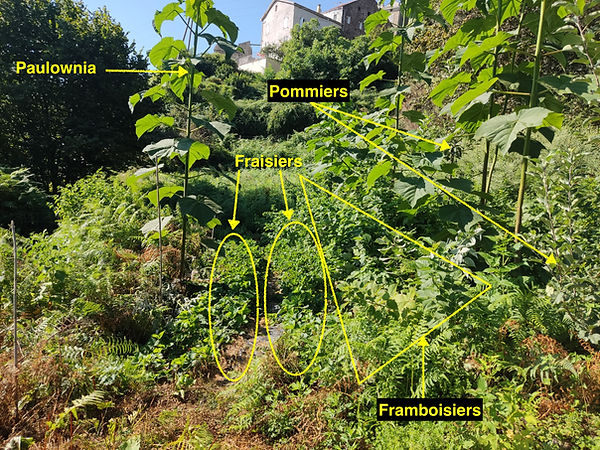
The food forest - syntropic agriculture
I am creating a food forest inspired by the principles of 'syntropic agriculture', a term coined by Ernst Götsch in Brazil (see https://www.youtube.com/watch?v=gSPNRu4ZPvE ). This agricultural method is based on two principles:
-
Imitate the ecological succession and the stratification of a natural forest.
-
Prune 'auxiliary trees' frequently to self-fertilise the forest.
I adapt these principles to my local context and add other agroforestry and agroecological practices to the system to create a locally-adapted highly-productive and aesthetically-pleasing system.
The base of the system is as following:
-every 4 meters I have planted a row of fruit trees and shrubs. In +-10/15 years, these trees will touch each other and there will hardly be any place left between the rows. Within every tree row, I have planted fruit trees and shrubs every 4 m and between the fruit trees I have planted 'auxiliary trees', or pioneer species. These trees grow quickly, produce a lot of biomass, and protect the vulnerable young fruit trees from wind and sun. They are pruned frequently and the biomass is put on the soil where they protect the soil against evaporation and where they increase the amount of organic matter. This method of mulching mimics the functioning of a natural forest and stimulates a healthy growth of the fruit trees.
-in between the tree rows I have planted different vegetables and or fruit shrubs like potatoes, strawberries, eggplants, sweet potatoes, tomatoes, beans, raspberries, gooseberries and currants. These crops will grow only the first ten years or so when there is still enough sunlight available and they actually pay for the plantation of the fruit trees that take much longer to produce any value.
Below I describe in more detail a system following these principles based on red fruits.

To mimic ecological succession, I have planted two rows that consist of different crops on either side of the row of fruit trees. These rows consist of raspberries, gooseberries and currants.
.jpg)

October 2020 ; the garden before I planted the food forest

September 2021 : 7 months after planting the food forest

September 2021 : 7 months after planting the food forest

The pictures show the results of the syntropic agriculture (food forest) part of the garden. This part of the garden follows the principles outlined in the above illustrations. There is a central row consisting of apple trees, plums and figs with pioneer species planted in high densities in between them (in this case Paulownia). On one side of this central tree row, there is a row of gooseberries and on the other side there is a row of raspberries. In between the two berry rows (where the soil is bare), I have planted strawberries. Lastly, I have planted climbing plants such as kiwi berry in the central fruit tree rows (but not visible on the pictures).
The following photos are taken at the beginning of the project (October 2020), September 2021 and July 2022. I started the project in January 2021 and started planting the syntropic food forest in March 2021. Paulownias reached 4m in July 2022, which means it only took 16 months to reach that size!
The results :
-partial shade creating the perfect microclimate for strawberries and raspberries growing under the paulownia
- excellent working conditions for the farmer
-protection of apple trees from sunburn
-biomass which is used as mulch to fertilize fruit trees
-nesting and resting places for birds, increasing the diversity and resilience of the system against pests
-provide support for climbers such as hardy kiwi and grapevine.
I only did it on a small scale but imagine doing this on a scale of several hectares; in just 16 months, we can create a food forest with all of these positive effects! Instead of growing raspberries and strawberries between the rows of paulownias, we could also grow vegetables that will benefit from shade and reduced evapotranspiration compared to the open field. With the extremely hot spring and summer we've had this year, I can guarantee that for farmers, having trees is a game changer!
July 2022 : 16 months after planting the food forest

Check out my blog for updates on the food forest and the syntropic agroforestry experiment!
July 2022 : 16 months after planting the food forest

July 2022 : happy farmer :)

Design of the syntropic agroforestry system described above. See photo below of the same place one year later!

May 2024: only 3 years after its birth, the system is already very well developed and productive!


